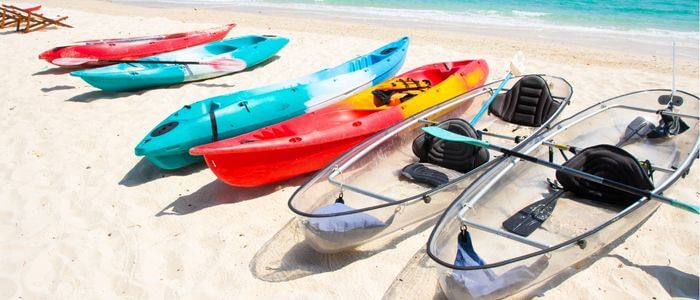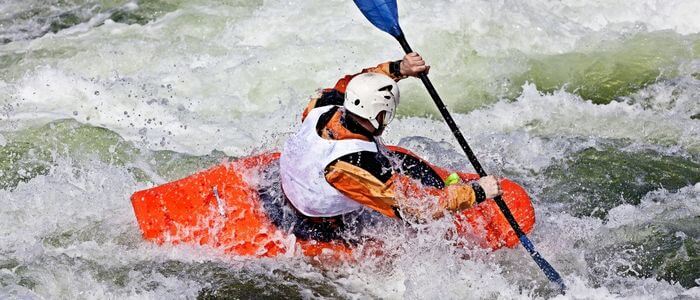
Whether you are a seasoned veteran or a beginner just getting started, one thing is certain – kayaking requires skill and precision to navigate the water. But how fast does an average kayak travel? And what factors affect your speed when you’re out on the water? In this article, we will explore these questions and more as we look at the average kayak speed for different types of kayaking. We will also consider some key factors that can impact your speed when paddling and tips for staying safe while traveling at faster speeds.
So if you’re interested in learning more about this exciting sport, read on!
NOTE: 1.15 MPH = 1 KNOT
When it comes to kayaking, the speed of your kayak will depend largely on a number of different factors. These include things like:
That being said, if you were to ask, “what is the average speed for a kayak?” there isn’t an easy answer, as speeds can vary greatly depending on all of these factors.
However, according to some experts, available kayaks typically reach speeds of anywhere from 2 to 3 knots, while kayaks designed for racing can reach speeds of up to 5 or 6 knots.
Similarly, different kayaks can travel at different average speeds. So, let’s discuss some of the different types of kayaking and how the average kayak speed varies depending on different factors.
The average speed of a recreational or touring kayak can vary depending on several factors, such as the length and width of the kayak, the skill and strength of the paddler, the water conditions, and the type of stroke being used. Recreational kayaks are designed for leisurely paddling on calm waters and are not built for speed. They typically have a wide and stable hull design, making them slower in the water compared to other kayaks.
Tourist kayaks are longer and narrower than recreational kayaks, which makes them faster on the water. However, the speed of a touring kayak can also be affected by the same factors mentioned above. Generally, the average speed for a recreational or touring kayak on calm water is around 3-3 knots. This can vary depending on the paddler’s strength and technique, as well as the length and design of the kayak.
The average speed of a fishing kayak can vary depending on the same factors that affect the speed of recreational or touring kayaks, such as the length and width of the kayak, the skill and strength of the paddler, the water conditions, and the type of stroke being used. Fishing kayaks are generally wider and more stable than other types of kayaks, which can make them slower on the water. They are designed for stability and ease of use rather than speed.
Generally, the average speed for a fishing kayak on calm water is around 1-2 knots. This can vary depending on the paddler’s strength and technique, as well as the length and design of the kayak. Some fishing kayaks have built-in trolling motors, which can help to increase their speed on the water. However, these motors are generally not powerful enough to significantly increase the kayak’s speed, and they are primarily used to help the kayak maintain a steady course in one direction.
The average speed of a whitewater kayak can vary significantly depending on the type of river or stream being paddled, as well as the skill and experience of the paddler. Whitewater kayaks are generally designed for maneuverability and stability in fast-moving, turbulent water rather than for speed. They have a shorter and wider hull design, making them highly responsive to the paddler’s movements, but they can also make them slower on the water compared to other kayaks.
On a turbulent whitewater river, the average speed of a whitewater kayak may be as low as 2-3 knots, depending on the strength and technique of the paddler. However, on a faster-moving, more predictable river stretch, a whitewater kayak’s average speed may be closer to 4-5 knots. Again, this can vary depending on the skill and strength of the paddler, as well as the length and design of the kayak.
Generally, the average speed for a sea kayak on calm water is around 4-5 knots. This can vary depending on the paddler’s strength and technique, as well as the length and design of the kayak. Some sea kayaks have a rudder or skeg, which can help improve their tracking and stability on the water, but they are not typically used to increase the kayak’s speed.
Besides, the average speed of a sea kayak can vary depending on the same factors that affect the speed of other types of kayaks, such as the length and width of the kayak, the skill and strength of the paddler, the water conditions, and the type of stroke being used.
Sea kayaks are generally longer and narrower than other kayaks, making them faster on the water. They are designed for efficient paddling over long distances and are often used for touring and expeditions on open bodies of water such as the ocean, bays, and large lakes.
So, as you can see, a kayak’s average speed depends on several factors, including the type of kayaking being done. Whether you’re out fishing or touring, the average speed of your kayak will largely depend on your skill and experience as a paddler, as well as the design and length of the boat itself.
However, regardless of what kind of kayaking you’re doing, it’s always important to paddle safely and with care to ensure everyone stays safe and enjoys their time on the water!

When determining the safest kayaking speed, no single answer will apply to all paddlers. The best way to determine a safe and comfortable speed for yourself is through experience and practice. As you gain more experience out on the water, you’ll be able to develop your skill as a paddler and learn what speeds are most comfortable for you based on the water conditions, wind, weather, etc.
That being said, it’s generally recommended to paddle at a slow or moderate pace when you’re first starting kayaking. This ensures you have plenty of time to react in unexpected conditions or situations on the water. Additionally, if you’re new to kayaking and are still learning the basics, stay within sight of other kayakers or people on shore who can assist if needed.
As you gain more experience, you’ll be able to determine what speed is right for you based on your skill and water conditions. However, regardless of your experience out on the water, always paddle with care and caution to ensure your safety and that of others around you!
But how fast can an average person kayak? Can we increase speed while kayaking? Let’s discuss all these things in detail so you can have a better answer.
The average speed at which an average person can kayak can vary significantly depending on several factors, such as the person’s strength, endurance, and kayaking experience, as well as the length and design of the kayak and the water conditions.
In general, the average speed for a kayak on calm water is around 2-3 knots, although this can vary depending on the skill and technique of the paddler, as well as the length and design of the kayak.
Some kayakers can paddle at speeds of up to 5-6 knots, although this would be quite fast and require a high level of skill, strength, and endurance.
It is important to note that the average speed of a kayak is not the only factor to consider when evaluating a person’s kayaking ability. Other factors, such as the person’s ability to navigate challenging water conditions and handle the kayak in rough or choppy water, can also be important. In general, the average person in the good physical condition and has some kayaking experience should be able to paddle a kayak at an average speed of 2-3 knots on calm water.
In general, kayaking faster is not necessarily beneficial or harmful in and of itself. The speed at which a person kayaks may be affected by factors such as the person’s skill and strength, the length and design of the kayak, and the water conditions. Some people may kayak at faster speeds for various reasons, such as to cover longer distances more efficiently, to compete in races, or to enjoy moving more quickly through the water.
However, it is important to consider the potential risks and challenges of kayaking at faster speeds. For example, kayaking at faster speeds may require more physical exertion and may be more strenuous on the body, which could increase the risk of fatigue or injury. In addition, kayaking at faster speeds may require a higher level of skill and experience to navigate challenging water conditions and handle the kayak safely.
Overall, whether kayaking faster is beneficial or harmful will depend on the individual’s personal goals and abilities, as well as the specific circumstances and conditions in which they are kayaking. It is important always to prioritize safety and to be aware of your limitations and the potential risks of kayaking at faster speeds.
But if you still want to increase your kayak speed, don’t worry.
There are several ways to increase the speed of a kayak, depending on the type of kayak and the specific circumstances in which it is being paddled. Some general tips for increasing kayak speed include:
It is important to note that the specific techniques and strategies for increasing kayak speed will vary depending on the type of kayak and the specific circumstances in which it is being paddled. It is always important to prioritize safety and be aware of your limitations when attempting to increase your kayaking speed.
Whether you are kayaking for exercise, enjoyment, or fishing, it is important to know the average kayak speed for your particular type of kayaking. Many factors can affect your speed on the water, including your skill level, the length and design of your kayak, and the water conditions.
However, there are also several ways to increase your kayak speed, such as using proper technique and training to improve your fitness and strength. Always prioritize safety and be aware of your limitations when attempting to increase your kayaking speed. However, with the right preparation and mindset, you can enjoy a faster and more efficient kayaking experience!

Hey there kayak lovers! I’m Jay Schwartz, the author here at Kayak Guidance! You know water sports – you know me! My life is all about it. Kayaking, Paddleboarding, Fishing, Snorkeling and so much more. I love to share my passion and knowledge with all of you.

Hey there kayak lovers! I’m Jay Schwartz, the author here at Kayak Guidance! You know water sports – you know me! My life is all about it. Kayaking, Paddleboarding, Fishing, Snorkeling and so much more. I love to share my passion and knowledge with all of you.

Welcome to KayakGuidance.com! If you’re looking to have some fun outdoor water adventures, then you have come to the right place. We help our readers find the best kayaks and water related equipment to help you have the best time of your life whenever you are engaging in water activities.
This site is a participant in the Amazon services LLC associates program, an affiliate advertising program designed to provide a means for sites to earn advertising fees by advertising and linking to Amazon.com.